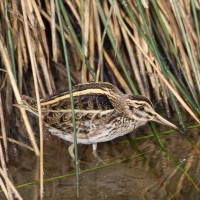Descrição
The area around Horn kyrka is a quite good site for geese with hundreds of Ganso-campestre, Ganso-comum, and Ganso do Canadá found most years. Often with lesser amounts of Ganso-grande-de-testa-branca, Tundra Bean Goose, Ganso-de-bico-curto, and Ganso-de-faces-brancas interspersed. Ganso-de-faces-negras has been seen. Most geese are found by Rien (marked with a star on the map) in late Febuary and March.
During the spring Riens water overflow and large amounts of open water form. When this happens large amounts of Pato-real (at most 200), and Marrequinha-comum (at most 150) rest in the area. Among these ducks you can observe smaller amounts of Piadeira, Frisada, Piadeira, Arrabio (uncommon), Pato-trombeteiro (uncommon), and Marreco (rare). Sometimes also some diving ducks. But since water levels vary each spring the amount and variation of ducks at Rien vary accordingly. The wetland at Hornebergs holds permanent water, and usually some dabbling ducks, but not in the same amount. Horn Marsh along with its ponds is also quite good for small amounts of different dabbling ducks.
Diving ducks are most usually found in Åsunden with Merganso-grande, Zarro-negrinha, Pato-olho-d'ouro being common, while Merganso-de-poupa and Merganso-pequeno are uncommon. At Trossbonäs rare diving ducks like Pato-preto, and Pato-fusco can be found with luck in April. Even Eider-edredão and Zarro-bastardo have been seen there.
In spring if Rien has water in late April waders rest there. Maçarico-bastardo, Pássaro-bique-bique (at most 23), Abibe-comum, and Narceja-comum (at most 100). On the fields Tarambola-dourada, at Åsunden Maçarico-das-rochas sing, and in the forests Galinhola can be found. During heavy autumn rain Rien can gain enough water for waders such as Perna-verde-comum, Combatente, Pilrito-comum, Maçarico-real, Borrelho-grande-de-coleira, and Pilrito-de-bico-comprido. The fields around Bränna and Västa eneby are pretty good areas for Narceja-galega in November.
Among predatory birds peneireiro-de-dorso-malhado / peneireiro, Águia-d'asa-redonda, Bútio-vespeiro, Búteo-calçado, Águia-rabalva, Gavião da Europa, Açor, Águia-pesqueira, Ógea and Tartaranhão-azulado are all common. Águia-real, Esmerilhão, falcão-peregrino, and Milhafre-preto are all rare but seen some years. The best places for them are Bränna, Rien, and Åshorva.
Large amounts of passerine birds move along the fields around Horn, therefore large amounts of Pintarroxo-comum, Petinha-dos-prados, alvéola-amarela and other common meadows birds are found along with other rare passerine birds like Pisco-de-peito-azul, Melro-de-peito-branco, Escrevedeira da Lapónia (very rare), Escrevedeira-das-neves, and Pintarroxo-de-bico-amarelo. The best places for these are Bränna and Rien.
The wetland around Rien and Hornsberg have large amounts of reed and trees which make them excellent places for nightactive birds. All the common bird are found some years with Codornizão, Codorniz, Felosa-das-moitas, Felosa-fluvial, Franga-d'água-grande, and Felosa-malhada. Even Franga-d'água-bastarda has been found.
Detalhes
Acesso
Horn is located on the southern shores of lake Åsunden. No good parking spots can be found for most of these places but it is often possible to park alongside the road. The area is best explored with bike or car and perhaps not best suited to tourists because there are few facilities for visitors.





